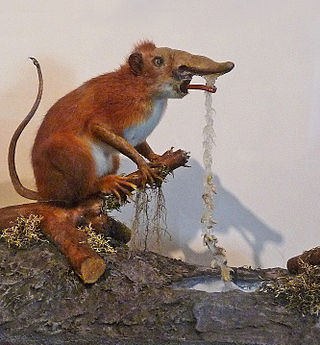
The Percolozoa are a group of colourless, non-photosynthetic Excavata, including many that can transform between amoeboid, flagellate, and cyst stages.

The Eurovision Song Contest 1967 was the 12th edition of the annual Eurovision Song Contest. It took place in Vienna, Austria, following the country's victory at the 1966 contest with the song "Merci, Chérie" by Udo Jürgens. Organised by the European Broadcasting Union (EBU) and host broadcaster Österreichischer Rundfunk (ORF), the contest was held at the Großer Festsaal der Wiener Hofburg on 8 April 1967, becoming the first contest held in the month of April, and was hosted by Austrian actress Erica Vaal.

Rhinogradentia is a fictitious order of extinct shrew-like mammals invented by German zoologist Gerolf Steiner. Members of the order, known as rhinogrades or snouters, are characterized by a nose-like feature called a "nasorium", which evolved to fulfill a wide variety of functions in different species. Steiner also created a fictional persona, naturalist Harald Stümpke, who is credited as author of the 1961 book Bau und Leben der Rhinogradentia. According to Steiner, it is the only remaining record of the animals, which were wiped out, along with all the world's Rhinogradentia researchers, when the small Pacific archipelago they inhabited sank into the ocean due to nearby atomic bomb testing.

Latridiidae is a family of tiny, little-known beetles commonly called minute brown scavenger beetles or fungus beetles. The number of described species currently stands at around 1050 in 29 genera but the number of species is undoubtedly much higher than this and increases each time a new estimate is made.

The Hemiscylliidae are a family of sharks in the order Orectolobiformes, commonly known as longtail carpet sharks and sometimes as bamboo sharks. They are found in shallow waters of the tropical Indo-Pacific.
The Botanical and Zoological Codes of nomenclature treat the concept of synonymy differently.

Kathrine Virginia Switzer is an American marathon runner, author, and television commentator.
Hartmannella is a genus of Amoebozoa.

Vahlkampfiidae is a family of Heterolobosea.

The drop bear is a hoax in contemporary Australian folklore featuring a predatory, carnivorous version of the koala. This imaginary animal is commonly spoken about in tall tales designed to scare tourists. While koalas are typically docile herbivores, drop bears are described as unusually large and vicious marsupials that inhabit treetops and attack unsuspecting people that walk beneath them by dropping onto their heads from above.

Virgaviridae is a family of positive-strand RNA viruses. Plants serve as natural hosts. The name of the family is derived from the Latin word virga (rod), as all viruses in this family are rod-shaped. There are currently 59 species in this family, divided among seven genera.
Vahlkampfia avara is a species of excavates. It has a PAS-positive surface layer and forms cysts in culture.
Vahlkampfia jugosa is a species of excavates. It has a PAS-positive surface layer and forms cysts in culture.

The Blissidae are a family in the Hemiptera, comprising nearly 50 genera and 400 species. The group has often been treated as a subfamily of the Lygaeidae but was resurrected as a full family by Thomas Henry (1997).
Chalkydri are mythical creatures mentioned in the apocryphal Second Book of Enoch from the 1st century CE, often seen as an angelic species. In the narrative, chalkydri dwell near the Sun and ran its course around the Earth with it bringing heat and dew to the Earth. The chalkydri and phoenixes are described as creatures with the head of a crocodile and the feet and tail like that of a lion, each having twelve wings, and are the color purple like the rainbow. The phoenixes in Greek myth are not the same mentioned here. At sunrise, all the chalkydri break into song with their counterparts, alerting the birds of the world for a new day to rejoice.

"Long Legged Girl (with the Short Dress On)" is a song first recorded by Elvis Presley as part of the soundtrack for his 1967 MGM motion picture Double Trouble.
Portugal was represented by Eduardo Nascimento, with the song "O vento mudou", at the 1967 Eurovision Song Contest, which took place on 8 April in Vienna. "O vento mudou" was chosen as the Portuguese entry at the Grande Prémio TV da Canção Portuguesa on 25 February. Eduardo Nascimento was the first black male singer in the history of the Eurovision Song Contest. Rumours claimed that Portuguese prime minister Salazar had chosen this particular singer to show the rest of Europe that he was not racist.
Finland was represented by Fredi, with the song "Varjoon – suojaan", at the 1967 Eurovision Song Contest, which took place on 8 April in Vienna.

The Interim Register of Marine and Nonmarine Genera (IRMNG) is a taxonomic database which attempts to cover published genus names for all domains of life, from 1758 in zoology up to the present, arranged in a single, internally consistent taxonomic hierarchy, for the benefit of Biodiversity Informatics initiatives plus general users of biodiversity (taxonomic) information. In addition to containing just over 500,000 published genus name instances as at May 2023, the database holds over 1.7 million species names, although this component of the data is not maintained in as current or complete state as the genus-level holdings. IRMNG can be queried online for access to the latest version of the dataset and is also made available as periodic snapshots or data dumps for import/upload into other systems as desired. The database was commenced in 2006 at the then CSIRO Division of Marine and Atmospheric Research in Australia and, since 2016, has been hosted at the Flanders Marine Institute (VLIZ) in Belgium.










